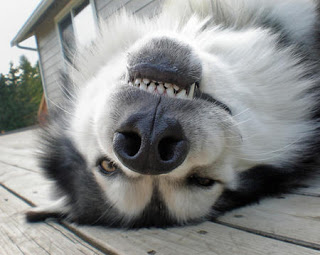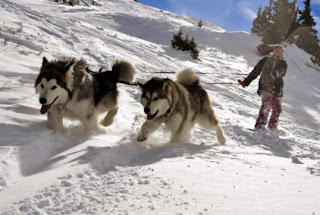Description
The Alaskan Malamute is the largest of the Arctic dogs. This thick well built dog is solid with a plumed tail which is held over the back. The head is wide with erect ears. The eyes are of medium size, dark brown, small, and almond in shape and are obliquely placed in the skull. The dog holds an image of a wolf but with a proud, sweet expression. Dark eyes are preferred. Blue eyes are a fault according to the written standard.
The feet are large, of the snowshoe type with tough pads. The thick, coarse double coat averages one to three inches in length and comes in a range of light gray to intermediate shadings of black, sable and shadings of sable to red. Combinations include, wolf gray, black & white, wolf sable (red undercoat with dark gray outer coat), or red. The only solid color allowed is white. The dog often has darker highlights and sometimes has a dark mask or cap. The legs and muzzle are almost always white. In some areas, dogs may be either smaller or larger than the official standard.
Temperament
The Alaskan Malamute is extremely loyal and intelligent, sweet and most affectionate toward it's master. Great with children who are old enough to play with him safely. If their canine instincts are met, they mature into a dignified and mellow adult dog. They are very friendly and therefore are not suitable as a
guard dog. Malamutes are happiest living outdoors as long as they receive enough companionship, but they also enjoy living indoors where their human "pack" lives. Without firm leadership and daily mental and physical exercise, these dogs may become destructive nuisances, acting like a big, rambunctious puppy.
In one case, a single dog ruined an entire living room of furniture valued at $15,000 in just three hours! Malamutes love outdoor activities and even do well in obedience with firm encouragement. Although it can be difficult to train Malamutes for formal obedience, it is not particularly hard to train them to be well-mannered because they love to please. Males can be very dominant. This breed needs the humans around him to be firm, confident and consistent pack leaders. Some dogs may be difficult to housebreak.
This breed is a thrifty feeder and needs less food than you might expect. However they do tend to wolf down whatever is offered, which can lead to obesity and bloat. Malamutes are quiet compared to most dogs but they do like to howl and dig. This breed should be supervised around unfamiliar small animals, as they have a strong prey instinct. This does not mean they are not good with small animals. Some Malamutes have been known to raise small kittens as their own. Both sexes can be combative with other dogs, especially with the same sex and breed and firm handling and training are necessary to curve this. Proper socialization with people and other dogs is imperative. Obedience training is highly recommended.
Height, Weight
Height-Dogs 24-26 inches (61-66 cm.) Bitches 22-24 inches (56-61 cm.)
Weight-Dogs 80-95 pounds (36-43 kg.) Bitches 70-85 pounds (32-38 kg.)
Health Problems
The Alaskan Malamute is prone to bloat, hip dysplasia and chondrodysplasia (dwarfism).
Living Conditions
Alaskan Malamutes are not recommended for apartment life. They are fairly active indoors and should have at least a large yard. If you live in a suburban area, a high fence is a must, but bury the base, because they are likely to dig their way out. Alaskan Malamutes like to roam in what he considers to be his territory. The Malamutes coat allows them to withstand extreme cold, but be careful to keep the dog cool in hot climates. Make sure they have shade and plenty of clean cool water.
Exercise
Malamutes need a reasonable amount of exercise with include long daily walks. But be careful not to overdue it in warm weather.
Life Expectancy
About 12-15 years.
Litter Size
Average of 6 puppies
Grooming
The Alaskan Malamute has a dense coat and should be brushed twice a week. This breed sheds very heavily. The undercoat comes out in clumps twice a year. Bathing is most unnecessary, as the coat sheds dirt readily. Dry shampoo occasionally. This dog is clean and odorless.
Origin
The Alaskan Malamute is a Nordic sled dog, descended from the Arctic wolf. Its name comes from Mahlemuts, an Alaskan tribe that raised and cared for these beautiful snow dogs. Originally used 2000 to 3000 years ago by these Mahlemuit Eskimos of Alaska, these highly valued dogs were their only form of transportation. These amazing dogs have strength, endurance with a will to work. They pulled not only light traveling sleds, but they also hauled heavy loads of food and supplies for the Arctic people.
Packs of Malamutes have participated in many polar expeditions, for which they are particularly well adapted due to their tenacity, sense of direction, and excellent sense of smell. They have appeared as unforgettable characters in the stories of Jack London and Rudyard Kipling. The Malamute went with Admiral Byrd's expeditions to the pole. The Alaskan Malamute is cousins with the Arctic breeds, Siberian Husky, Samoyed, and the American Eskimo dog. Some of the Alaskan Malamute's talents are sledding, carting, search & rescue, weight pulling and racing.
The Alaskan Malamute is the largest of the Arctic dogs. This thick well built dog is solid with a plumed tail which is held over the back. The head is wide with erect ears. The eyes are of medium size, dark brown, small, and almond in shape and are obliquely placed in the skull. The dog holds an image of a wolf but with a proud, sweet expression. Dark eyes are preferred. Blue eyes are a fault according to the written standard.
 |
Alaskan Malamute |
Temperament
The Alaskan Malamute is extremely loyal and intelligent, sweet and most affectionate toward it's master. Great with children who are old enough to play with him safely. If their canine instincts are met, they mature into a dignified and mellow adult dog. They are very friendly and therefore are not suitable as a
 |
Alaskan Malamute |
In one case, a single dog ruined an entire living room of furniture valued at $15,000 in just three hours! Malamutes love outdoor activities and even do well in obedience with firm encouragement. Although it can be difficult to train Malamutes for formal obedience, it is not particularly hard to train them to be well-mannered because they love to please. Males can be very dominant. This breed needs the humans around him to be firm, confident and consistent pack leaders. Some dogs may be difficult to housebreak.
 |
Alaskan Malamute |
Height, Weight
Height-Dogs 24-26 inches (61-66 cm.) Bitches 22-24 inches (56-61 cm.)
Weight-Dogs 80-95 pounds (36-43 kg.) Bitches 70-85 pounds (32-38 kg.)
 |
Alaskan Malamute And Women |
The Alaskan Malamute is prone to bloat, hip dysplasia and chondrodysplasia (dwarfism).
Living Conditions
Alaskan Malamutes are not recommended for apartment life. They are fairly active indoors and should have at least a large yard. If you live in a suburban area, a high fence is a must, but bury the base, because they are likely to dig their way out. Alaskan Malamutes like to roam in what he considers to be his territory. The Malamutes coat allows them to withstand extreme cold, but be careful to keep the dog cool in hot climates. Make sure they have shade and plenty of clean cool water.
Exercise
Malamutes need a reasonable amount of exercise with include long daily walks. But be careful not to overdue it in warm weather.
Life Expectancy
About 12-15 years.
Litter Size
Average of 6 puppies
 |
Alaskan Malamute in 2 Months Old |
The Alaskan Malamute has a dense coat and should be brushed twice a week. This breed sheds very heavily. The undercoat comes out in clumps twice a year. Bathing is most unnecessary, as the coat sheds dirt readily. Dry shampoo occasionally. This dog is clean and odorless.
Origin
The Alaskan Malamute is a Nordic sled dog, descended from the Arctic wolf. Its name comes from Mahlemuts, an Alaskan tribe that raised and cared for these beautiful snow dogs. Originally used 2000 to 3000 years ago by these Mahlemuit Eskimos of Alaska, these highly valued dogs were their only form of transportation. These amazing dogs have strength, endurance with a will to work. They pulled not only light traveling sleds, but they also hauled heavy loads of food and supplies for the Arctic people.
Packs of Malamutes have participated in many polar expeditions, for which they are particularly well adapted due to their tenacity, sense of direction, and excellent sense of smell. They have appeared as unforgettable characters in the stories of Jack London and Rudyard Kipling. The Malamute went with Admiral Byrd's expeditions to the pole. The Alaskan Malamute is cousins with the Arctic breeds, Siberian Husky, Samoyed, and the American Eskimo dog. Some of the Alaskan Malamute's talents are sledding, carting, search & rescue, weight pulling and racing.
No comments:
Post a Comment